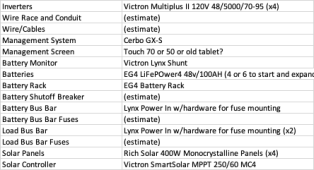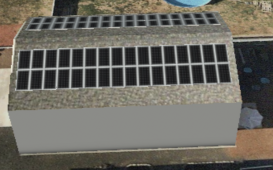BlindBadger
New Member
Hi All! I'm trying to plan out a victron-based grid-tie (ish) inverter setup for my home in WA, USA and I'd love you veterans' thoughts on the plan and the design (including if the whole design is dumb and I should consider a different direction or vendor).
Being in the USA (and in a city suburb) and being that there's significant electrical work, I'll likely need a permit, which means everything has to meet state regulations (be certified or listed by one of these organizations: WA State Certification Organization List ). Very few bits of Victron gear meet this, sadly...but I'm also about a year out from purchasing and installing the equipment so I'm hoping the "UL Pending" status updates by then for the 48/5000/70/95 inverter charger. (No Quattros are UL or anything qualified certified for the US)
My very unoriginal overall goals are:
What I found was:

Solar stuff is just guesstimates right now...EG4 batteries because they have the UL stickers for inspection (which the cheaper SOK batteries don't have, sadly). The Lynx stuff is primarily to help me stay organized in what is plugged in where (as seen in the diagram below) and account for future expansion in multiple battery banks and more solar charge controllers).
The high level wiring design I was trying to figure out is below: (no monitoring or comms cables shown)

Does that all look right? I'm still not completely clear as to why the grounds and neutrals go where they do on the house-load side of the victrons, but that's what I see in the quattro 120/240 split diagrams I've seen on the victron site (though none of the diagrams I've seen have more than 2 inverters, even though they're allowed to go up to 6 per phase -.- ).
I could go with Sol-Ark 15k units (x2) and save myself a lot of components and space, but it works out to be slightly more expensive in the end at $22k-$24k (though I do get a bit more capacity at 24kw inverting, instead of 16k)
So...am I at least on the right track? Have I made a grave mistake?
Being in the USA (and in a city suburb) and being that there's significant electrical work, I'll likely need a permit, which means everything has to meet state regulations (be certified or listed by one of these organizations: WA State Certification Organization List ). Very few bits of Victron gear meet this, sadly...but I'm also about a year out from purchasing and installing the equipment so I'm hoping the "UL Pending" status updates by then for the 48/5000/70/95 inverter charger. (No Quattros are UL or anything qualified certified for the US)
My very unoriginal overall goals are:
- Be able to live like normal off-grid (power-wise)
- Save money by using solar and batteries as much as possible
- Stage 1 focus: Be able to live fully off-grid during peak hours (time-of-use isn't here yet but it's only a matter of time...my utility already publishes the intended rates for it when they implement it). Implement small 1k-ish solar system on the garage at the same time to help lower cost and qualify for state tax incentives (which require a minimum of 1kw solar system to qualify). Outside of the solar production, charge the batteries from the grid during off-peak times to run during peak times.
- Stage 2 focus: Expand solar and batteries to generate enough power to charge the batteries for those peak times, reducing reliance on the grid.
- Stage 3+ focus: Continue expanding solar and batteries until I can live off-grid even in the winter (thankfully, I have a good amount of roof space with a 1200ft main house with lots of south facing roof, and a 36x54 shop that also has a large south facing roof).
What I found was:
- I average 68kWh a day with a maximum of 126kWh in the winter (I'm still digging into why I use so much in the winter when my heating source is natural gas but that's an investigation for another time)
- I picked that 126kWh day and grabbed the peak hour usage and it was 29kWh and 30kWh for each of the two peak time segments. This is my "worst case scenario" for stage 1 and gives me a target for the battery capacity for that stage to carry me through peak hours on battery power alone.
- With the Emporia Vue, I was able to measure my mains and get some details on my heavy loads (House Central Air Conditioning, Loft Mini-Split, Dryer, Oven, and furnace fan) and with all of those on and the rest of the house in "normal operating mode", I would be around 11kW. I could probably get away with a 12kw system but it seems a bit close and I hate running close to the limits, so I'm aiming for whatever the next size up is (in this victron system, it would be 16kw at 4x5000va/4000w inverters).

Solar stuff is just guesstimates right now...EG4 batteries because they have the UL stickers for inspection (which the cheaper SOK batteries don't have, sadly). The Lynx stuff is primarily to help me stay organized in what is plugged in where (as seen in the diagram below) and account for future expansion in multiple battery banks and more solar charge controllers).
The high level wiring design I was trying to figure out is below: (no monitoring or comms cables shown)

Does that all look right? I'm still not completely clear as to why the grounds and neutrals go where they do on the house-load side of the victrons, but that's what I see in the quattro 120/240 split diagrams I've seen on the victron site (though none of the diagrams I've seen have more than 2 inverters, even though they're allowed to go up to 6 per phase -.- ).
I could go with Sol-Ark 15k units (x2) and save myself a lot of components and space, but it works out to be slightly more expensive in the end at $22k-$24k (though I do get a bit more capacity at 24kw inverting, instead of 16k)
So...am I at least on the right track? Have I made a grave mistake?



